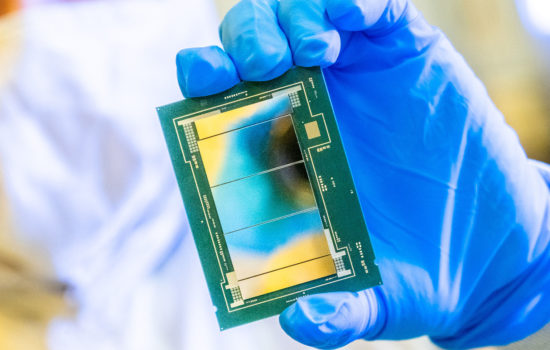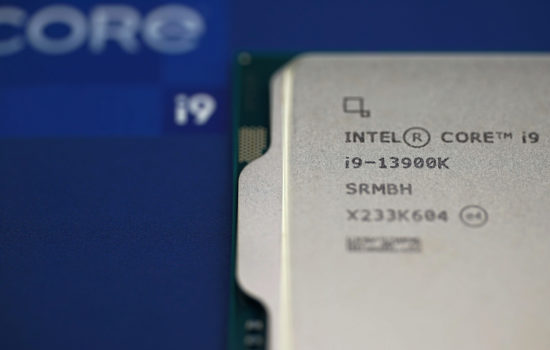11th generation desktop Intel Core: models, specifications, prices
The wait for Intel desktop processors with the new architecture is almost over. The 11th generation Core for desktop was officially released last week and it’s just days to sales and reviews. Intel has now officially announced the complete specifications and especially the prices of all models. The most powerful Core i9-11900K will go for $ 539 or almost € 550, but a 6-core for cheap gaming PCs will go for mere € 160/$ 157.
The new 11th generation Core for desktop was officially revealed last tuesday (in line with the previously leaked date). Intel has now officially announced the complete specifications, so the only thing remaining is to wait till March 30th for reviews and sales start.
A lot about Rocket Lake has already been leaked, and Intel has pre-announced or teased these chips at least twice now (in October, later in January). But we have been in the dark about prices until now, which will be the crucial factor for how competitive these last 14nm Intel processors will be against AMD’s 7nm Ryzen 5000.
The first post-Skylake desktop CPU design meets the last 14nm desktop chip
The concept of Rocket Lake chips has long been known: these are the final 14nm Intel processors before 10nm chips come to the desktop. Despite that, these processors are introducing a new architecture: Intel has converted their new Sunny Cove core from 10nm Ice Lake processors to the 14nm node and integrated it into Rocket Lake processors under the name Cypress Cove. Ironically, it actually achieves much higher clock speed on 14 nm. The clock reaches 5.0–5.3 GHz, and at the same time the architecture is supposed to reach to 19% better performance per 1 MHz compared to current desktop processors with Skylake/Comet Lake architecture. Another advantage is support for AVX-512 and DL Boost instructions, for the first time in a mainstream desktop socket.
Rocket Lake likewise offers a new integrated GPU, which in turn comes from Tiger Lake processors, so it already uses the new Xe architecture, including support for HDMI 2.0 and AV1 decoding. It contains 256 shaders and is designated as UHD Graphics 750 (we covered it here) or UHD 730 for a cut-down version with 192 shaders.
Rocket Lake is also Intel’s first desktop processor series to support DDR4-3200 and PCI Express 4.0: the processors provide a PCIe 4.0 ×16 interface for GPUs and another PCIe 4.0 ×4 for SSDs, which do not have to be connected to the chipset thanks to this and can communicate directly with the processor, which lowers latency.
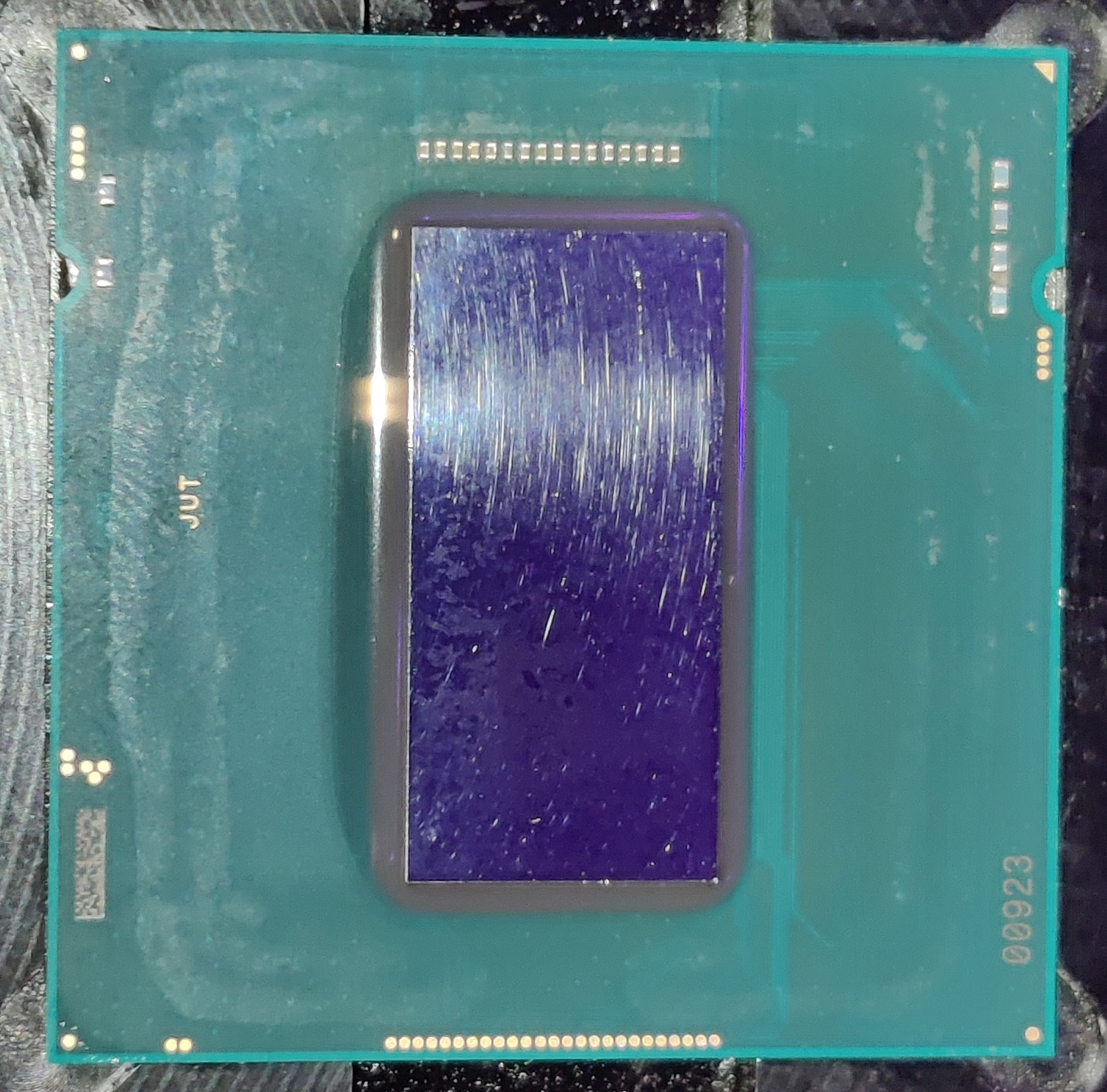
A tip: Delid and a photo of the Intel Rocket Lake chip. Silicon has an area of up to 270 mm²
Rocket Lake uses the same LGA 1200 platform as Comet Lake does, so you will be able to upgrade to it, but this is mostly true for Z490 motherboards (not all chipsets and boards support this new CPUs and older boards also may not always allow the use of PCIe 4.0 ×4 for SSD).
If you use a new motherboards, you will also get support for SuperSpeed USB 20Gbps (USB 3.2 Gen 2×2) and in case of boards with the Z590 and H570 chipsets, there’s yet another advantage: DMI ×8, which means the connection between the chipset and the processor has been widened to double bandwidth (up to 8 GB/s, minus some overhead).
For gaming PCs, a significant innovation actually happens in the product segmentation. Until now, Intel has not allowed overclocking memory (even via XMP profiles) above the officially supported frequency unless you had a motherboard with the Z490 chipset. The frequency was capped to the what the processor officially supports. With the new 500-series boards, however, it will for the first timebe possible to overclock DDR4 on boards with the B560 and H570 chipset. This should help the game performance a lot and opens the possibility to build a gaming PC with cost-effective B560 boards and locked 65W processors.
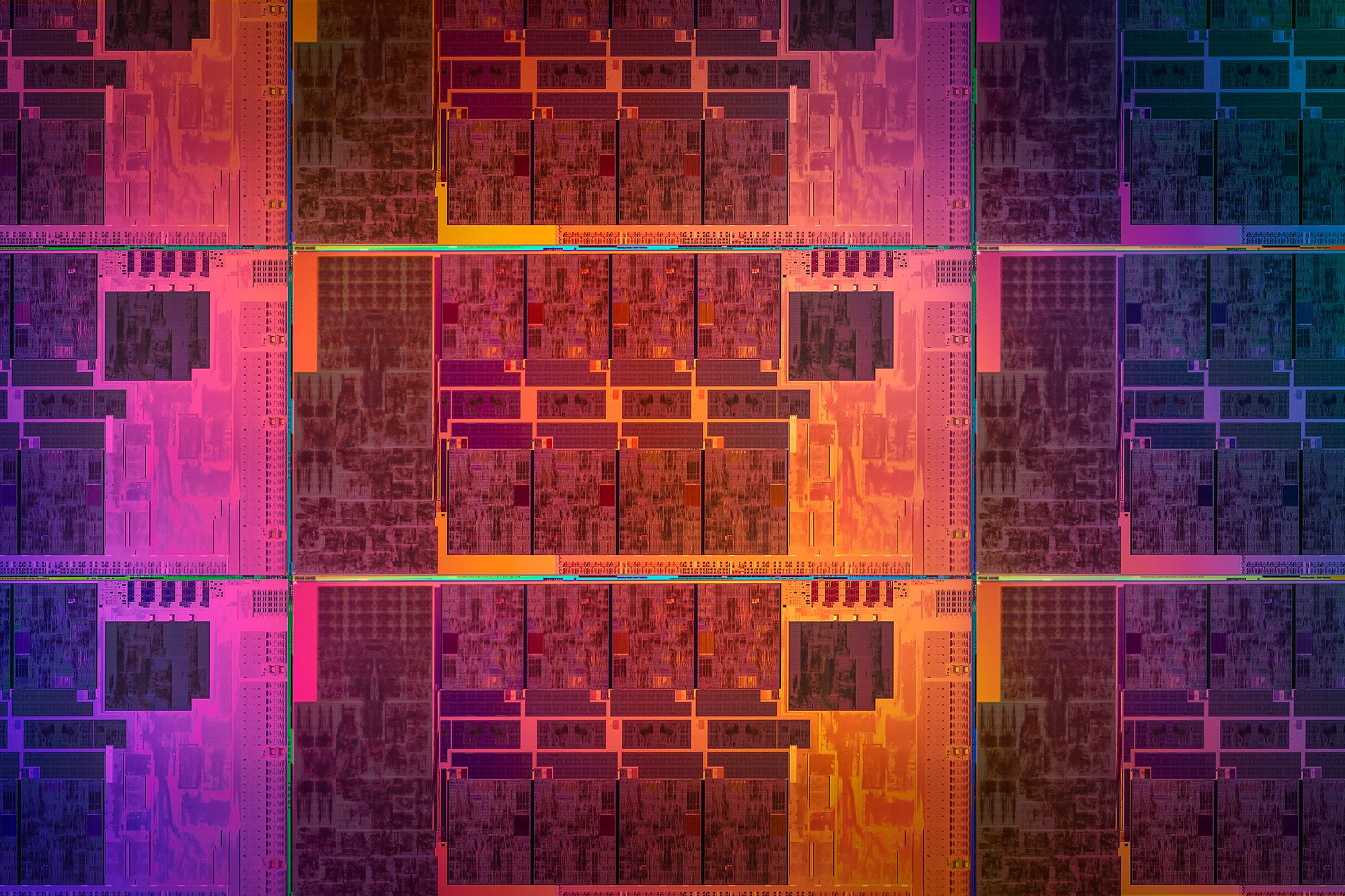
Models: Rocket Core i9, i7 and i5
Intel’s 11th generation Core chips will be released in the following model lines: i5 with six cores and Core i7 and Core i9 both with eight cores. There won’t be a deca-core version, unlike in to the previous Comet Lakegeneration, possibly because the architecture intended for 10nm technology results in a very large 14nm chip. In addition, Intel will also not produce any quad-core or dual-core Rocket Lake products, these price ranges will continue to be serviced by the 10th generation Core (Comet Lake).
A small note: Intel’s TDP values are quoted in the following text and also in the tables, but these power consumption values are based on processor running at its base clock. During boost the processors can significantly exceed their TDP – which technically should only happen for a limited time (so-called “tau” that should be 56 seconds), but motherboards often change this setting to virtually infinite duration. It is expected that the power draw during boost could reach up to 200 W and more when there’ load on all cores of octa-core processors – this will even happen with the “65W” models. Intel sets a cap for power draw during boost, the so-called PL2. But they don’t state PL2 values in the specifications (and by the way, PL2 can also be re-adjusted upwards by motherboards).

Octa-core
You can see the full specs in the table below. The Core i9-11900K is the highest performance option: it’s 125W SKU with unlocked multiplier, 8 cores and 16 threads with 3.5 GHz base clock. Maximum single-threaded boost is 5.3 GHz. The Core i9-11900KF also has the same specs (except it lacks integrated UHD 750 graphics). The price for the model with iGPU enabled is $ 539 (in SK/CZ it is € 547/CZK 14,315), but the version without iGPU is “only” $ 513 (€ 521/CZK 13,625).
Turbo again happens to be quite complicated. 5.3 GHz is the clock speed with Thermal Velocity Boost. If the temperature limit (which is 70 °C) is exceeded, the maximum boost is only 5.2 GHz. However, this is using the Turbo Boost Max 3.0 technology, i.e. only happens on the favored cores. The standard maximum without Turbo 3.0 doing its thing is only 5.1 GHz. With all cores active, the maximum clock is 4.8 GHz, but without Thermal Velocity Boost (above 70 °C) that changes to only 4.7 GHz.
These two processors will be the only ones to officially support DDR4-3200 memory with a memory controller frequency of 1:1 (i.e. without a memory divider). All the other following models officially support DDR4-3200 with a ½:1 divider only and the maximum they support with the full 1:1 ratio is DDR4-2933. It has to be said that in practice, even cheaper CPUs can seemingly work with 1:1 ratio, which many motherboards might even enable automatically.
The Core i9-11900 and Core i9-11900F are locked 65W models and do not allow overclocking. These can be described in quite a simple way: their clock speeds are always exactly 100 MHz lower than on the 125W SKUs, only the base clock differs more, it is only 2.5 GHz. The rest exactly copies the 125W model, just with the clock speeds always one step lower. The maximum single-core Thermal Velocity Boost is therefore 5.2 GHz and all-core boost is 4.7 GHz (only 4.6 GHz above 70 °C, without TVB). These models cost $ 439 and $ 422 for the version without GPU – which translates to € 446/CZK 11,660 and € 429/CZK 11,210.
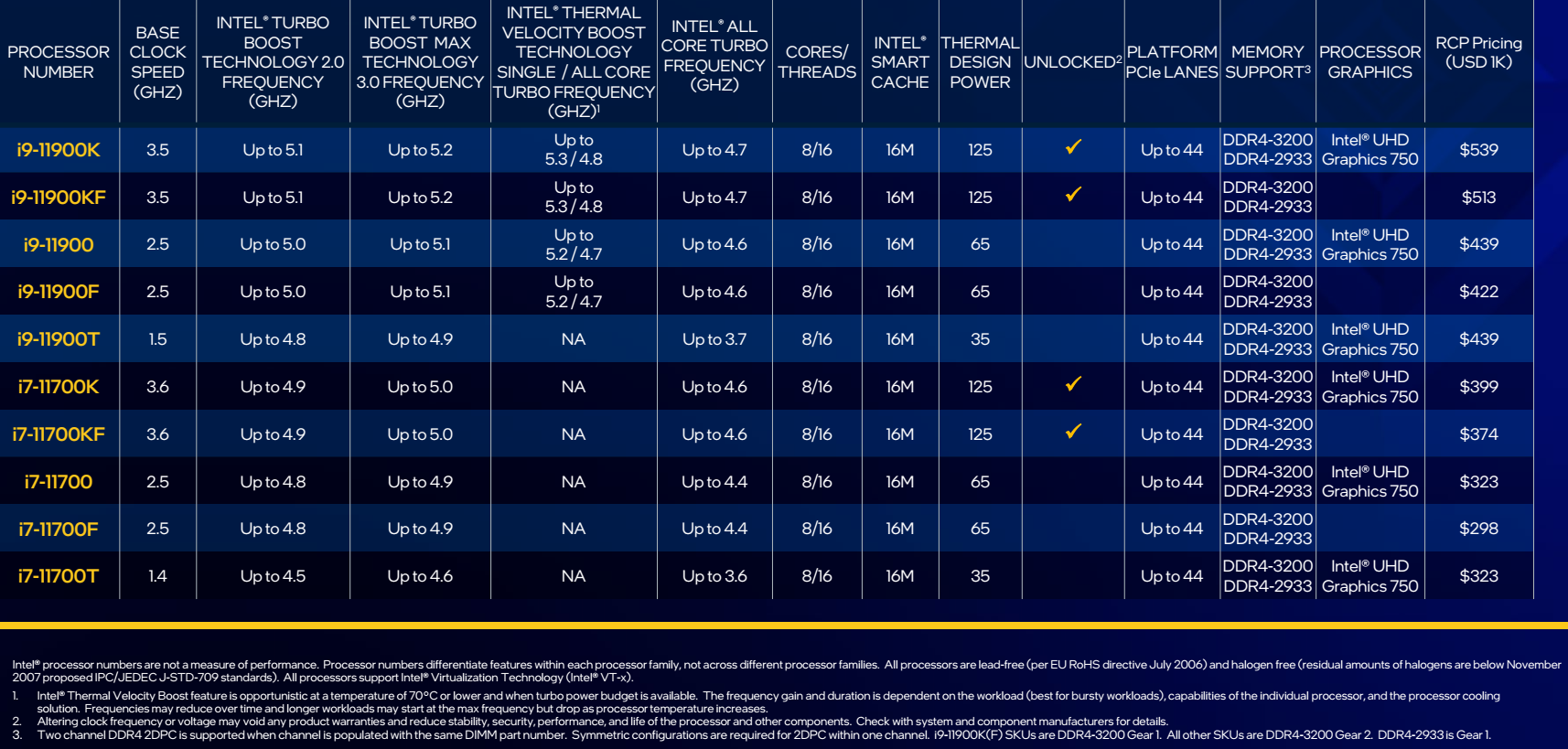
Core i7: octa-core almost same as the i9
In addition to the Core i9, however, Intel will also offer Core i7 processors, which will be octa-cores with 16 threads too and won’t be much worse – in fact, they seem to differ only in the clock speed (and the afore-mentioned complication with DDR4-3200, which in practice may not be always present), because they have the even have 16 MB L3 cache capacity.
The unlocked 125W octa-core Core i7-11700K (and Core i7-11700KF without iGPU) has a base clock of 3.6 GHz, but the maximum boost is “only” 5.0 GHz this time – it’s without Thermal Velocity Boost, which the i7 models don’t retain, but including Turbo Boost Max 3.0 (so the clock speed only applies to favored cores, outside those the maximum is 4.9 GHz). Again, two cores can reach this limit at the same time. And 4.6 GHz is the maximum for all cores simultaneously. These processors will cost $ 399 and $ 374 (KF version without iGPU), i.e. € 406/CZK 10,600 and € 380/CZK 9,930.
There are again locked 65W versions of Core i7-11700 and Core i7-11700F without iGPU, too. Their base clock is 2.5 GHz. Here too the 65W models have their clock speeds 100 MHz lower than the 125W models. The maximum boost for 1–2 preferred cores is 4.9 GHz (only 4.8 GHz without Turbo Max 3.0), with the exception that their all-core boost is reduced by 200 instead of 100 MHz and is only 4.4 GHz. So these 65W models have a bit more diminished performance than 65W Core i9 SKUs do. But at the same time we are approaching interesting territory in terms of price, Intel will only want $ 323 for the GPU-enabled version and only $ 298 for the model without iGPU – i.e. € 328/CZK 8,580 and € 303/CZK 7,915. The Core i7-11700F could perhaps be the very most attractive model of Rocket Lake.
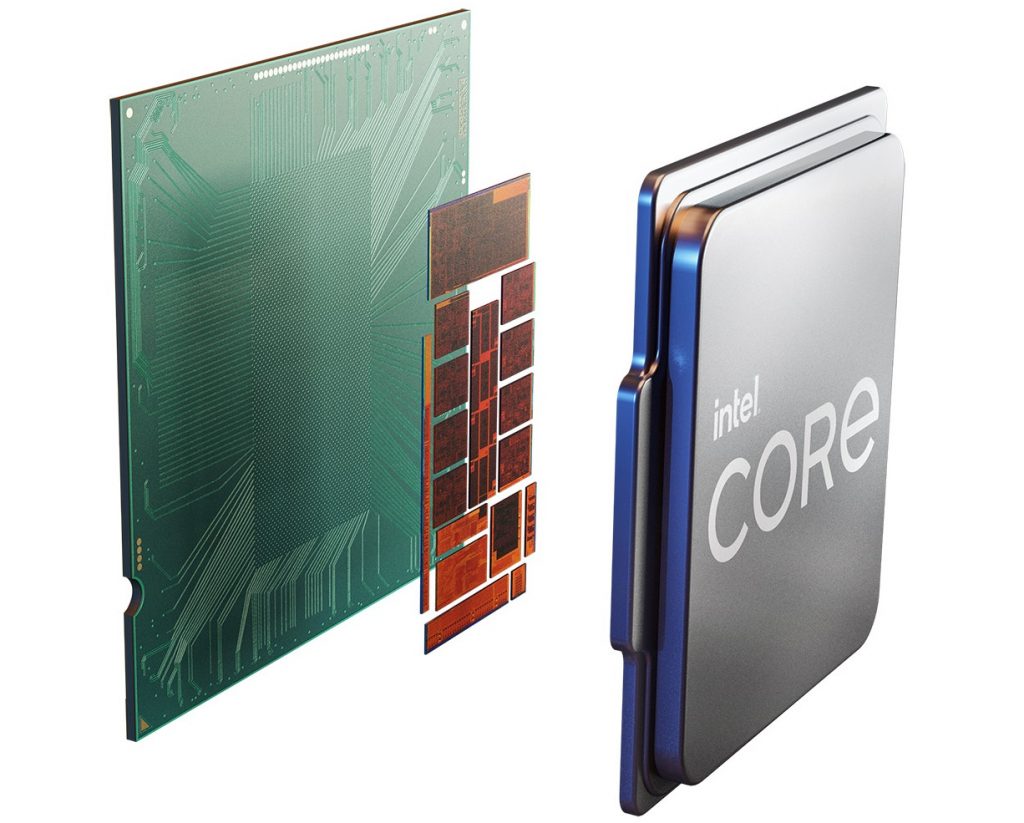
Hexa-cores
Intel is preparing quite a few hexa-core models. They all have 12 threads and 12 MB L3 cache. Only the Core i5-11600K and Core i5-11600KF with 125W TDP will be unlocked for overclocking. These have a 3.9 GHz base clock, a maximum boost of 4.9 GHz and maximum all core boost of 4.6 GHz. The price is $ 262 for regular version and $ 237 for the KF model without GPU, i.e. € 266/CZK 6,960 and € 241/CZK 6,295.
Locked six-core models include the Core i5-11600 (2.8 to 4.8 GHz, all core boost up to 4.3 GHz), Core i5-11500 (2.7 to 4.6 GHz, all core boost up to 4.2 GHz) and Core i5-11400 (2.6 to 4.4 GHz, all core boost up to 4.2 GHz), for $ 213, $ 192 and $ 182 and in Slovakia/Czech Republic about € 216 /CZK 5,660, € 195/CZK 5,100 and € 185/CZK 4,835. The Core i5-11400 has one more compromise to it besides its lower clock speeds: while all other Rocket Lake processors except the F/KF variants provide UHD 750 integrated graphics with 256 shaders, the Core i5-11400 only has a cut-down version with 192 shaders called UHD 730. Intel apparently makes use of chips with a defect in the iGPU area, in this SKU.
There will also be the Core i5-11400F version without graphics and otherwise with the same parameters for sale. This could be the most interesting choice for cheap gaming computers, because of the price of only $ 157, i.e. € 160/CZK 4,170. The question is how high the performance will be with boosts of only 4.2 to 4.4 GHz, but it should be a decent advancement against the i5-10400F.

Quad-core and dual-core: Comet Lake refresh
Unfortunately no cheaper Rocket Lake/Cypress Cove processors than this will be offered. For the rest of the lineup (Core i3, Pentium and Celeron) Intel will simply reusethe chips from previous generation. They just made a refresh models with a 100 MHz higher clock speed. These refreshed models have a model numbers ending in five, such as Core i5-11105F.
The fact that this is merely a Comet Lake refresh has the disadvantage that the integrated graphics will not support HDMI 2.0 or AV1 decoding like UHD 750/730 will. And of course, the CPUs won’t get the additional bonuses of the new architecture like AVX-512. You can see an overview of the models in the table again.
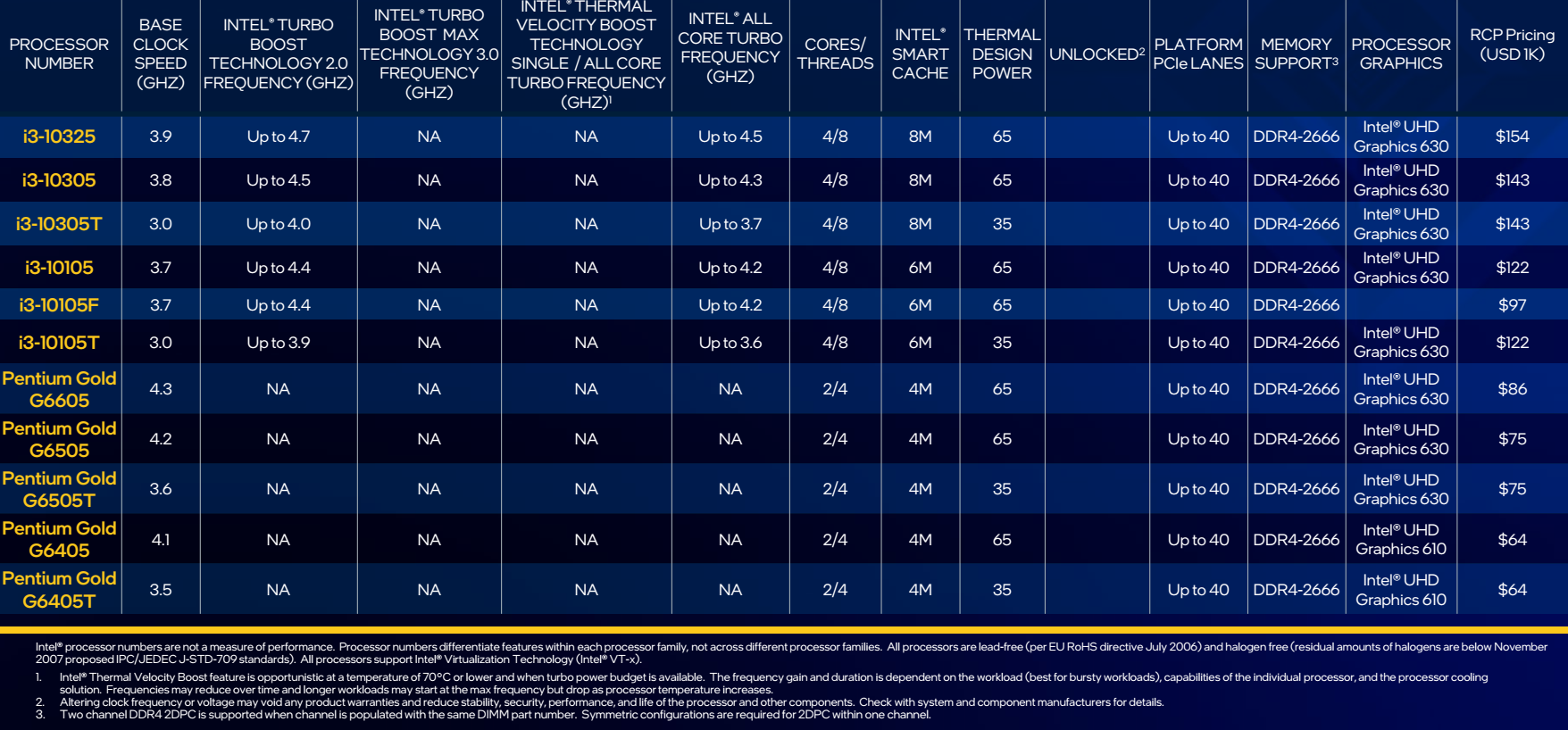
35W models, optionally limited to 25 W
35W Rocket Lake models could also be interesting, but we do not yet know what their real boost power draw limit (PL2) is. You can see the Core i9-11900T in the prior tables. It has a base clock of only 1.5 GHz (this probably shows how much has Intel to lower the clock for Rocket Lake chip to always fit within 35 W). However, the maximum all-core boost is up to 3.7 GHz (which, judging by the base clock of 125W models, could lead to a power draw of about 120 to 130 W). The maximum boost for one to two cores is up to 4.9 GHz with Turbo Boost Max 3.0, without it just 4.8 GHz. Thermal Velocity Boost is not used on the 35W model.
The cheaper Core i7-11700T also has eight cores and 16 threads, but its base clock is only 1.4 GHz. Maximum boost for the two favored cores is still high at 4.6 GHz (without Turbo Max 3.0 it’s 4.5 GHz) and with all cores active, the boost is only 3.6 GHz.
Hexa-cores will also be offered in the T-line: the Core i5-11600T (1.7–4.1 GHz), Core i5-11500T (1.5–3.9 GHz) and Core i5-11400T (1.3–3.7 GHz).
These 35W models can optionally be further limited to 25W TDP, where they’ll reach even lower base clocks. But they will probably still consume much more power when boosting, so if a low maximum power draw is needed, you will likely have to adjust PL2 manually – but of course then you will not reach the stated all-core boost specified in the specifications.

In the stores in a week or so
We have already mentioned the prices, so only one last piece of info is left: when will you be able to obtain a Rocket Lake? Sales of these processors will begin in little over a week, on March 30. Reviews of these processors should also be published on the same day.
Translated, original text by:
Jan Olšan, editor for Cnews.cz






